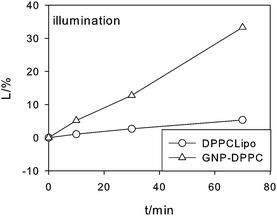Construction of thermal- and light-responsive liposomes noncovalently decorated with gold nanoparticles†
Yuqiong Xia*,
Shuo Qi,
Xinlong Zhang,
Lei Li,
Xiaochao Qu*,
Xianghan Zhang and
Jimin Liang
School of Life Science and Technology, Xidian University, Engineering Research Center of Molecular and Neuro Imaging, Ministry of Education, Xi’an, Shaanxi, China. E-mail: yqxia@xidian.edu.cn; Fax: +86 2981891060; Tel: +86 2981891070
First published on 29th August 2014
Abstract
Liposome-nanoparticle assemblies (LNAs) are promising drug carriers that can easily encapsulate drugs and probes and can manifest smart responses to the environment. Here in this work, we constructed a GNP–liposome complex, called GNP–DPPC, by decorating GNPs onto the surface of thermal-responsive DPPC liposomes using noncovalent interactions. We found that the introduction of GNP not only gives GNP–DPPC a higher CLT (critical leakage temperature), but also causes GNP–DPPC to have a faster leakage near its CLT. Furthermore, GNP–DPPC could release contents under the illumination of a 532 nm laser beam, which is a relatively mild condition. Moreover, GNP–DPPC is stable in cell media and can be absorbed into cells. Such light-induced contents release behavior and fast thermal response, as well as its cellular behavior, would make it a candidate for further use in drug delivery in living cells.
1 Introduction
The last decade has witnessed the rapid development of nanoparticles for use in targeted imaging and/or as therapeutic agents. Among all nanostructured materials, liposome-nanoparticle assemblies (LNAs) have attracted particular interest.1,2 This is because LNAs have the advantages of both liposomes and nanoparticles. On one hand, the liposomes in these LNAs can encapsulate both hydrophobic and hydrophilic drugs and probes. On the other hand, the nanoparticles enable LNAs to manifest smart responses and imaging properties, as well as stabilizing the liposomes.3–6Among all the nanoparticles in LNAs, gold nanoparticles (GNPs)7 are the most frequently investigated due to their typical local surface plasma resonance (LSPR) effects,8,9 which give GNPs the ability for photothermal conversion. GNPs can be decorated onto membrane surfaces (d-LNAs),10–17 incorporated into a lipid bilayer (b-LNAs)18–25 or encapsulated into the core interior of liposomes (e-LNAs).22,26,27 These subclasses of LNAs have different properties due to their structural differences.
In d-LNAs, the GNPs on the membrane surface could form either a unified gold shell,13,14 from which drugs could be released under the illumination of a near-infrared ray, or a discrete gold coating,15–17 which has a similar photothermal conversion reaction with better biodegradability. This is because the discrete coating of GNPs could be destroyed by the disruption of the liposomes. In b-LNAs the incorporated GNPs are usually very small (2 nm to 5 nm), and therefore UV illumination could induce leakage due to the non-resonant photothermal conversion of such small incorporated GNPs.22–25 For e-LNAs, as the GNPs are far from the membrane (compared with d-LNAs and b-LNAs), during photothermal conversion the disturbance of the liposomes is weakened and thus contents release is reduced.22 To have a satisfactory release efficiency, a high energy laser source like a 0.5 ns laser pulse,28 or a femtosecond laser27 could be used (the mechanism of the latter is not photothermal but photoacoustic conversion). Moreover, in some cases GNPs could crosslink several liposomes to form higher hierarchy aggregates, which are called c-LNAs.29
These subclasses of LNAs are not always suitable for further applications in vivo. Firstly, b-LNA is not safe for cells, since its use involves UV light, which is harmful to cells. Secondly, e-LNA is not efficient at contents release, since it can only release contents efficiently after illumination by a high energy pulse-laser. Thirdly, c-LNA is too large to be used in vivo, since it consists of several liposomes and is larger than 200 nm. However, d-LNA does not have the same problems as the other subclasses of LNA, but is safe to cells, efficient at contents release and a suitable size. Therefore, d-LNA is most suitable for further applications in vivo.
So far, most d-LNA is synthesized by chemically reducing HAuCl4 to GNPs or a gold shell on the membrane surface. However, there are very few studies on constructing d-LNA using noncovalent bonds.30 Noncovalently-bonded d-LNA is simple in structure, easy to prepare and modify, and environmentally friendly.
In this paper we constructed a GNP–liposome complex, called GNP–DPPC, by decorating GNPs onto the surface of thermal-responsive DPPC liposomes. GNP–DPPC is a d-LNA in which GNPs and DPPC liposomes are bonded noncovalently. We found that the introduction of GNPs enhances the stability of liposomes, by increasing the critical leakage temperature (CLT) of the DPPC liposomes by 1 °C. Moreover, GNP–DPPC has a more sensitive thermal response and faster leakage near its CLT. Furthermore, compared with the control DPPC liposome, which has no response to light exposure, GNP–DPPC could release contents under the illumination of a 532 nm laser beam, which is a relatively mild condition. Moreover, we investigated the stability of GNP–DPPC in cell media and its cellular uptake. Therefore, such light-induced contents release behavior and fast thermal response as well as its cellular behavior would make it a candidate for further use in drug delivery in living cells.
2 Materials and methods
2.1 Materials
The dry powder of 1,2-dipalmitoyl-sn-glycero-3-phosphocholine (DPPC, ≥99%), cholesterol (chol, ≥99%), Sephadex G-50 and an aqueous solution of gold nanoparticles (20 nm, 0.1 mM PBS) were purchased from Sigma. The chloroform solution of 16![[thin space (1/6-em)]](https://www.rsc.org/images/entities/char_2009.gif) :
:![[thin space (1/6-em)]](https://www.rsc.org/images/entities/char_2009.gif) 0 Liss Rhod PE was purchased from Avanti Polar Lipids. Glucose (C6H12O6·H2O, >99%) was obtained from the Sinopharm Chemical Reagent Co., Ltd, China. The powder of 2-[4-(2-hydroxyethyl)piperazin-1-yl]ethanesulfonic acid (Hepes, 99%) was purchased from Amresco, US. Calcein, Triton X-100 (99%), ammonium thiocyanate (97.5%), iron(III) chloride hexahydrate (97%) and phosphotungstic acid were purchased from J&K Chemical Ltd, China. Wahaha water (Wahaha Company, China) was used as pure water.
0 Liss Rhod PE was purchased from Avanti Polar Lipids. Glucose (C6H12O6·H2O, >99%) was obtained from the Sinopharm Chemical Reagent Co., Ltd, China. The powder of 2-[4-(2-hydroxyethyl)piperazin-1-yl]ethanesulfonic acid (Hepes, 99%) was purchased from Amresco, US. Calcein, Triton X-100 (99%), ammonium thiocyanate (97.5%), iron(III) chloride hexahydrate (97%) and phosphotungstic acid were purchased from J&K Chemical Ltd, China. Wahaha water (Wahaha Company, China) was used as pure water.
2.2 Preparation of liposomes
DPPC/chol 8![[thin space (1/6-em)]](https://www.rsc.org/images/entities/char_2009.gif) :
:![[thin space (1/6-em)]](https://www.rsc.org/images/entities/char_2009.gif) 2 (molar ratio) liposomes encapsulating calcein were prepared by a reverse phase evaporation method31 followed by extrusion. Briefly, the chloroform solution of a lipid mixture was added to a 50 mL pear-shaped flask, and then the solvent was removed under reduced pressure at 50 °C by a rotary evaporator. The lipid film was then redissolved in 3 mL of a mixed organic solution of chloroform and ether (1
2 (molar ratio) liposomes encapsulating calcein were prepared by a reverse phase evaporation method31 followed by extrusion. Briefly, the chloroform solution of a lipid mixture was added to a 50 mL pear-shaped flask, and then the solvent was removed under reduced pressure at 50 °C by a rotary evaporator. The lipid film was then redissolved in 3 mL of a mixed organic solution of chloroform and ether (1![[thin space (1/6-em)]](https://www.rsc.org/images/entities/char_2009.gif) :
:![[thin space (1/6-em)]](https://www.rsc.org/images/entities/char_2009.gif) 1, v/v). The organic solution was further mixed with 1 mL Buffer A (50 mM calcein, 0.9% glucose solution, 20 mM Hepes, 0.1 mM EDTA, pH = 7.3) and was then sonicated for 1–2 min in a 0 °C water bath. After that, the organic solvent was removed from the mixed solution under reduced pressure at 37 °C, and multilamellar liposomes were obtained. The multilamellar liposomes were then extruded through a 100 nm polycarbonate membrane using a mini-extruder, 21 times. The obtained unilamellar liposomes were then passed through a Sephadex G-50 column to remove nonencapsulated materials and residual organic solvent. The elution buffer was Buffer B (5% glucose with 20 mM Hepes, 0.1 mM EDTA, pH = 7.3). The concentration of DPPC in the purified liposomes was determined to be 1.8 mM by Stewart’s method.32
1, v/v). The organic solution was further mixed with 1 mL Buffer A (50 mM calcein, 0.9% glucose solution, 20 mM Hepes, 0.1 mM EDTA, pH = 7.3) and was then sonicated for 1–2 min in a 0 °C water bath. After that, the organic solvent was removed from the mixed solution under reduced pressure at 37 °C, and multilamellar liposomes were obtained. The multilamellar liposomes were then extruded through a 100 nm polycarbonate membrane using a mini-extruder, 21 times. The obtained unilamellar liposomes were then passed through a Sephadex G-50 column to remove nonencapsulated materials and residual organic solvent. The elution buffer was Buffer B (5% glucose with 20 mM Hepes, 0.1 mM EDTA, pH = 7.3). The concentration of DPPC in the purified liposomes was determined to be 1.8 mM by Stewart’s method.32
For cell studies, DPPC/chol 8![[thin space (1/6-em)]](https://www.rsc.org/images/entities/char_2009.gif) :
:![[thin space (1/6-em)]](https://www.rsc.org/images/entities/char_2009.gif) 2 (molar ratio) labeled with 1% fluorescent 16
2 (molar ratio) labeled with 1% fluorescent 16![[thin space (1/6-em)]](https://www.rsc.org/images/entities/char_2009.gif) :
:![[thin space (1/6-em)]](https://www.rsc.org/images/entities/char_2009.gif) 0 Liss Rhod PE (named DPPC–Rh) was prepared in the same way, and the concentration of DPPC in the liposomes was determined to be 6.4 mM.
0 Liss Rhod PE (named DPPC–Rh) was prepared in the same way, and the concentration of DPPC in the liposomes was determined to be 6.4 mM.
2.3 Preparation of GNP–DPPC
The GNP solution was prepared as follows: firstly, 9 mL of the commercial GNP solution was mixed with 1 mL of Hepes 10× (100 mM Hepes, 1 mM EDTA, pH = 7.3, 1 mL) to maintain the pH, and then 0.55 g glucose powder was added to adjust the osmotic pressure, which was equal to the osmotic pressure of the liposome solution.After the optimal mixing ratio was obtained (see ESI† for more details), we prepared the GNP–DPPC complex as follows: firstly, GNPs at 6.5 × 1011 particles per mL were titrated into equal volumes of DPPC (DPPC/chol 8![[thin space (1/6-em)]](https://www.rsc.org/images/entities/char_2009.gif) :
:![[thin space (1/6-em)]](https://www.rsc.org/images/entities/char_2009.gif) 2, DPPC 0.18 mM) under agitation. Next, the solution was kept under stirring for 30 min. After that, the excess unadsorbed GNPs were removed by centrifugation (Eppendorf Centrifuge 5810R) at 12
2, DPPC 0.18 mM) under agitation. Next, the solution was kept under stirring for 30 min. After that, the excess unadsorbed GNPs were removed by centrifugation (Eppendorf Centrifuge 5810R) at 12![[thin space (1/6-em)]](https://www.rsc.org/images/entities/char_2009.gif) 000 rpm for 30 min. Finally, the supernatant was collected for further investigation. In the control group, the same volume of Buffer B instead of GNPs was added into the DPPC solution, stirred and centrifuged under the same conditions and was collected (named DPPC–Lipo) for further investigation.
000 rpm for 30 min. Finally, the supernatant was collected for further investigation. In the control group, the same volume of Buffer B instead of GNPs was added into the DPPC solution, stirred and centrifuged under the same conditions and was collected (named DPPC–Lipo) for further investigation.
The GNP–DPPC-R complex was prepared using the optimal mixing ratio in the same way.
2.4 Transmission electron microscopy
Transmission electron microscopy measurements were performed with a H-600 (Hitachi) operated at a 75 kV accelerating voltage. 50 μL of the dispersions (0.18 mM DPPC) was placed on formvar/carbon coated copper grids and left for 18 min. Then the excess dispersions were removed with filter paper. After that, 50 μL 3% phosphotungstic acid was dropped on the copper grids and left for 4 min. Then the excess liquid was removed with filter paper.2.5 Thermal leakage measurement
The thermally-induced leakages from GNP–DPPC and DPPC–Lipo were investigated under both program-increasing temperature conditions and constant temperature conditions. The measurements were performed on an F7000 fluorescence spectrometer equipped with a RE5 refrigerated circulating bath (Froilabo). For program-increasing temperature measurements, the solutions were heated from 30 °C to 50 °C in intervals of 1 °C. The solution was allowed to rest for 5 min to reach equilibrium before each measurement was taken. The constant temperature measurements were taken under 37 °C and 42 °C, and the time interval was 5 min.The leakage from GNP–DPPC and DPPC–Lipo were measured according to the fluorescence of the leaked calcein. The percentage of the leakage was calculated as:
 | (1) |
2.6 Light-induced leakage measurements
For the light-induced leakage measurements, the sample solution (GNP–DPPC or DPPC–Lipo) was put into a square quartz cell which was transparent to the laser. A 200 mW laser (DD532-200-5, Huanic Corporation, Xi’an, China) at 532 nm with a diameter of 5 mm was used to induce leakage. The solution was exposed to the laser beam at room temperature and measurements were taken at time points of 10 min, 30 min and 70 min. At each time point, the fluorescence was measured and the leakage from GNP–DPPC or DPPC–Lipo was calculated according to eqn (1).2.7 Stability of GNP–DPPC in cell media
The stability of GNP–DPPC in cell media was estimated by measuring the size and encapsulation efficiency of GNP–DPPC in 10% FBS (fetal bovine serum) daily for a week. The dispersion of GNP–DPPC was prepared as follows: 0.3 mL of FBS was added into 2.7 mL of GNP–DPPC under stirring, and the mixture was kept under stirring for 20 min at 25 °C.The measurement of the size of GNP–DPPC in 10% FBS is similar to those of GNP–DPPC in Buffer B. The encapsulation efficiency of calcein in the GNP–DPPC dispersion (in 10% FBS) was determined according to Paasonen’s work.22 Briefly, the fluorescence of 1 mL GNP–DPPC dispersion was measured. Then the solution before and after adding 50 μL 10% Triton X-100 was measured using an F7000 (HITACHI). The encapsulation efficiency of calcein (EE) was calculated by:
 | (2) |
The encapsulation efficiencies of calcein in the GNP–DPPC dispersion (in Buffer B) and in the liposomes were measured in the same way.
2.8 Cellular uptake of GNP–DPPC–Rh
Measurement of the cellular uptake of GNP–DPPC–Rh was performed using U87 cells. U87 cells were cultured in Dulbecco’s modified Eagle’s medium (DMEM), supplemented with 10% FBS and 1% penicillin/streptomycin. For cellular uptake studies, GNP–DPPC–Rh (the final concentration of DPPC was 0.66 μM) was introduced to U87 cells (3.5 × 104 cells per mL) and incubated for 4 hours. Meanwhile, U87 cells without GNP–DPPC–Rh were used as a control. After incubation, cell medium containing free GNP–DPPC–Rh was removed, and the remaining cells on the bottom were washed with PBS and then supplemented with cell medium before observation under a fluorescent microscope (DMI 4000B, LEICA).3 Results and discussion
3.1 Size of GNP–DPPC
Dynamic Light Scattering (DLS) was used to measure the size distribution of the GNPs, liposomes and GNP–DPPC dispersion. As shown in Fig. 1A, GNPs in buffer B have a unimodal distribution with a mean diameter of 24 nm, while GNPs in 0.1 mM PBS have a diameter of 20 nm; this indicates that the glucose in Buffer B will not cause aggregation of GNPs and that Buffer B is suitable to use as the solvent in this work. Additionally, liposomes in Buffer B have a narrow distribution (PDI = 0.182) with a diameter of 168 nm; GNP–DPPC also has a narrow distribution (PDI = 0.083) with a diameter of 173 nm. Meanwhile, the zeta potential of the GNPs, liposomes and GNP–DPPC were measured. The values were −30.4 ± 15.6 mV, −7.0 ± 6.7 mV and −19.0 ± 12.8 mV, respectively. As GNP–DPPC is a little larger than the liposomes and carries a weak negative charge, the proportion of GNPs to liposomes must be relatively small. In addition, as GNPs are negatively charged and liposomes are weakly negatively charged, their interaction could only be a charge–dipole interaction; namely, the interaction between the charge on the GNPs’ surface and the dipole of the liposomes’ surface. Fig. 1B shows the morphology of GNP–DPPC. One GNP is only attached to one liposome at most, meaning that the non-covalent interactions between the GNPs and liposomes are relatively weak.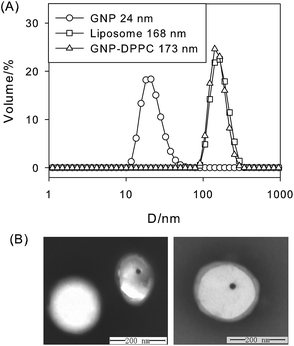 | ||
| Fig. 1 (A) Size distributions of GNPs, liposomes and GNP–DPPC in 5% glucose with Hepes buffer; (B) TEM images of GNP–DPPC. | ||
3.2 Thermal response of GNP–DPPC
In the liposomes, 20% cholesterol is incorporated to increase their stability, which does not affect the major transition temperature (Tk) of the liposomes. This is because the incorporation of less than 30% cholesterol in DPPC liposomes will not affect their major transition temperature, which is 41 °C according to Binder.33 Although the proportion of attached GNPs on the liposomes is relatively small, the attached GNPs should have an effect on the thermal response of the liposomes. Fig. 2 shows the contents leakage from DPPC–Lipo and GNP–DPPC under program-heating from 30 °C to 50 °C. For DPPC–Lipo, the leakage process can be divided into three stages: firstly, when the temperature is lower than 34 °C, no obvious leakage was observed; secondly, between 35 °C and 37 °C, a fast leakage was observed, and the leakage increased sharply from 17% to 55%; finally, after 38 °C the curve of the leakage became slow again. Based on the analysis of the leakage process, it can be determined that the CLT of DPPC–Lipo is 35 °C. It was noted that the pretransition temperature (Tp) and major transition temperature Tk of the DPPC liposomes are 41 °C and 35 °C, respectively,34 so we can conclude that such leakage is subject to the pretransition of liposomes. For the GNP–DPPC in which the DPPC liposomes were decorated by GNPs, a similar three-stage leakage curve was obtained. However, the CLT shifted up by 1 °C, and the fast leakage started at 36 °C (14%) and ended at 38 °C (42%). This indicates that GNPs have a stabilizing effect on liposomes. Since the lateral movement of lipids is essential for the pretransition of liposomes, in which the phase of the liposomes changes from a solid phase to a ripple phase,33 we conjecture that GNPs stabilize DPPC by immobilizing the lipids. The slow leakage in the final stage is probably due to the lower concentration gradient of calcein between the inside and outside of the liposomes.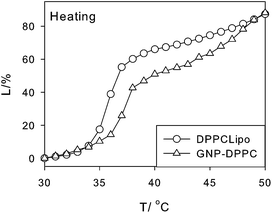 | ||
| Fig. 2 Thermal leakage from GNP–DPPC and DPPC–Lipo solutions under program-heating conditions from 30 °C to 50 °C with intervals of 1 °C. | ||
To further investigate the thermal response of GNP–DPPC and DPPC–Lipo, we monitored the kinetics of calcein release under constant temperature conditions. Since the CLTs for GNP–DPPC and DPPC–Lipo are 35 °C and 36 °C, respectively, we chose temperatures above 36 °C – namely, 37 °C and 42 °C – to ensure that both of them had thermal responses. Fig. 3A shows the calcein release of GNP–DPPC and DPPC–Lipo at 37 °C. Here the initial calcein leakage from GNP–DPPC was not equal to zero (3%), because the leakage had already started when the sample was incubated in the water bath before the zero time point. As can be seen from Fig. 3A, the release of calcein in GNP–DPPC was much faster than that in DPPC–Lipo at 37 °C over the whole time range. The maximum difference was up to 26%, which occurred at 20 min. Fig. 3B shows the kinetics of calcein release from GNP–DPPC and DPPC–Lipo at 42 °C. For the same reason, the initial calcein leakages from GNP–DPPC and DPPC–Lipo were 20% and 3%, respectively. However, after 5 min, their leakages were almost the same.
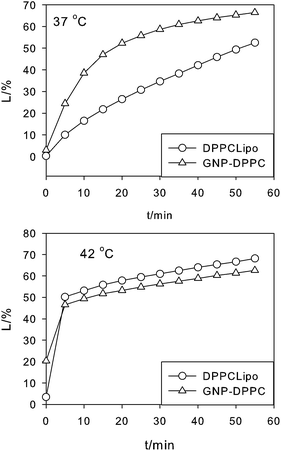 | ||
| Fig. 3 Thermal leakage from GNP–DPPC and DPPC–Lipo solutions under constant temperature conditions at 37 °C (A) and 42 °C (B). | ||
The faster leakage from GNP–DPPC could also be attributed to the immobilizing effect of GNPs on the lipids. Since the normal pretransition temperature of DPPC liposomes without GNPs is 35 °C, under the experimental conditions the lipids were only in ripple phase. However, the introduction of GNPs would stabilize lipids in some regions, where the pretransition temperatures were slightly increased. Therefore under the experimental condition of 37 °C these regions would stay in solid phase, while other regions were in ripple phase. This phase separation would enhance leakage, since calcein could be released from the phase boundaries. However, when the experimental temperature was 42 °C, which is greatly over Tp, the stabilization effect of GNP was overcome and such phase separation no longer existed. In this case the leakages from GNP–DPPC and DPPC–Lipo were more or less the same.
By combining the thermal leakages from GNP–DPPC in program-heating conditions and constant temperature conditions, we found that GNPs have dual effects on liposomes. On one hand, GNPs can stabilize DPPC liposomes by increasing the CLT by 1 °C; on the other hand, GNPs can also make DPPC liposomes more sensitive near the pretransition temperature. Both effects can be attributed to the immobilizing effect of GNPs on DPPC lipids.
3.3 Light response of GNP–DPPC
GNPs are well-known for their typical photothermal effects, while a lot of research has demonstrated that GNP-based LNAs can be triggered to release their contents by being exposed to a suitable laser beam.7–9 Since the resonant wavelength of the GNPs in this work is 520 nm (data not shown), we used a continuous laser of 532 nm to illuminate the GNP–DPPC and trigger contents release. Fig. 4 shows the light-induced calcein leakage from GNP–DPPC and DPPC–Lipo, where the latter is used as a control group. After 10 min of illumination, 5% calcein leaked from GNP–DPPC, while for the control DPPC–Lipo the calcein leakage was only 1% under the same conditions. After 30 min of illumination, the leakage from GNP–DPPC increased to 12%. Then after another 40 min exposure (70 min in all), the leakage rose to 33%. However, for the control DPPC–Lipo the leakage was 3% at 30 min and 5% at 70 min. Since the 5% leakage from DPPC–Lipo in this experiment is rather small, it indicates that the 532 nm laser has no significant thermal effect on either the phase behavior or the structure of the DPPC liposomes. Therefore, the 33% leakage in GNP–DPPC can only be attributed to the presence of the adsorbed GNPs. A possible mechanism is that under the illumination of the laser, GNPs absorb the photon energy, and the nearby lipids are heated to reach the pretransition temperature. Therefore a partial phase transition from solid phase to ripple phase occurs on the liposome. Such a phase separation triggers contents release. Therefore, it can be concluded that GNP–DPPC has a light response to lasers, based on the photo-thermal transition of GNPs on liposomes.3.4 Stability of GNP–DPPC in cell media
To investigate the stability of GNP–DPPC in cell media, the size and encapsulation efficiency (EE) of GNP–DPPC in 10% FBS were monitored for a week. As shown in Fig. 5A, on day zero, the day when the FBS was added into the original GNP–DPPC dispersion in Buffer B, the diameter was 168 nm, close to the original value (173 nm). This indicates that the GNP–DPPC didn’t aggregate in the presence of FBS. The diameter then stayed in the range of 164–186 nm for a whole week, which implies that the structure of GNP–DPPC is stable in 10% FBS. Furthermore, Fig. 5B shows the change in encapsulation efficiency of GNP–DPPC in 10% FBS, as well as those of the original GNP–DPPC dispersion and DPPC liposomes. Over a week, the decreases in the EEs of GNP–DPPC in 10% FBS, original GNP–DPPC dispersion and DPPC liposomes were 1.1%, 2.0% and 2.7%, respectively. Therefore, GNP–DPPC in 10% FBS is the most stable, followed by the original GNP–DPPC dispersion, and then the DPPC liposomes. These results further demonstrate that adsorbed GNPs on liposome surfaces are effective in increasing the stability of the liposomes. The FBS further increases the stability of the GNP–DPPC. This is probably due to the adsorption of serum proteins on the liposome surface.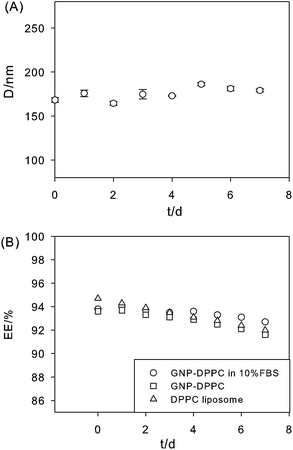 | ||
| Fig. 5 (A) Change in size of GNP–DPPC in 10% FBS over a week; (B) change in the encapsulation efficiency of GNP–DPPC in 10% FBS as well as those of GNP–DPPC in Buffer B and DPPC liposomes. | ||
3.5 Cellular uptake of GNP–DPPC–Rh
To observe the cellular uptake of GNP-decorated liposomes, GNP–DPPC–Rh (labeled with 16![[thin space (1/6-em)]](https://www.rsc.org/images/entities/char_2009.gif) :
:![[thin space (1/6-em)]](https://www.rsc.org/images/entities/char_2009.gif) 0 Liss Rhod PE) was used instead of GNP–DPPC. The diameter and zeta potential of the GNP–DPPC–Rh were 140 nm (Fig. S5†) and 0 ± 8.2 mV. As shown in Fig. 6A and A′, the cells themselves were visible under a light microscope, but not under a fluorescent microscope. However, after the cells were incubated with GNP–DPPC–Rh at 37 °C for 4 h, almost all the cells were visible both under a light microscope and under a fluorescent microscope (Fig. 6B and B′). The fluorescence in the cells must come from the absorbed fluorescent GNP–DPPC–Rh. Therefore, GNP–DPPC–Rh can be further used in cell studies.
0 Liss Rhod PE) was used instead of GNP–DPPC. The diameter and zeta potential of the GNP–DPPC–Rh were 140 nm (Fig. S5†) and 0 ± 8.2 mV. As shown in Fig. 6A and A′, the cells themselves were visible under a light microscope, but not under a fluorescent microscope. However, after the cells were incubated with GNP–DPPC–Rh at 37 °C for 4 h, almost all the cells were visible both under a light microscope and under a fluorescent microscope (Fig. 6B and B′). The fluorescence in the cells must come from the absorbed fluorescent GNP–DPPC–Rh. Therefore, GNP–DPPC–Rh can be further used in cell studies.
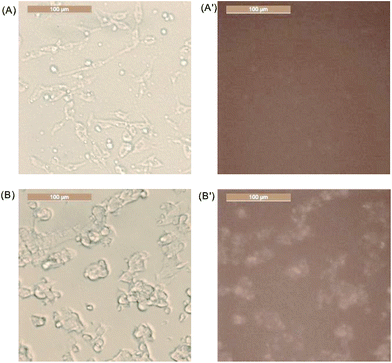 | ||
| Fig. 6 (A and A′) Light microscope and fluorescent images of controlled cells; (B and B′) light microscope and fluorescent images of cellular uptake after incubation with GNP–DPPC for 4 h at 37 °C. | ||
4 Conclusion
In conclusion, we have synthesized a GNP–liposome complex called GNP–DPPC, in which GNPs are decorated onto the surface of DPPC liposomes by noncovalent interactions. The synthesis is convenient and environmentally friendly. The resulting GNP–DPPC complex has both thermal- and light-responsive properties. The introduction of GNPs enhances the stability of the DPPC liposomes by increasing their CLT by 1 °C. Moreover, GNP–DPPC has a more sensitive thermal response and faster leakage near its CLT. Furthermore, GNP–DPPC has a light response, i.e., contents leakage, to mild laser exposure. Moreover, GNP–DPPC is stable in cell media and can be absorbed by cells. Such sensitive thermal- and light-induced contents release behaviors would therefore make GNP–DPPC a potential drug carrier to be used in living cells.Acknowledgements
This work was supported in part by the Program of the National Basic Research and Development Program of China (973) under Grant no. 2011CB707702, the National Natural Science Foundation of China under Grant nos 81227901, 81090272, 81201137, 81371589, Natural Science Basis Research Plan in Shaanxi Province of China under Grant no. 2013JQ4040 and the Fundamental Research Funds for the Central Universities under Grant no. K5051310003. Thanks to Prof. Han Xiang’e in Xidian University for kind offer of the laser.References
- M. R. Preiss and G. D. Bothun, Expert Opin. Drug Delivery, 2011, 8, 1025–1040 CrossRef CAS PubMed.
- R. Michel and M. Gradzielski, Int. J. Mol. Sci., 2012, 13, 11610–11642 CrossRef CAS PubMed.
- L. F. Zhang and S. Granick, Nano Lett., 2006, 6, 694–698 CrossRef CAS PubMed.
- B. Wang, L. F. Zhang, S. C. Bae and S. Granick, Proc. Natl. Acad. Sci. U. S. A., 2008, 105, 18171–18175 CrossRef CAS PubMed.
- A. Munoz Javier, P. Del Pino, M. F. Bedard, D. Ho, A. G. Skirtach, G. B. Sukhorukov, C. Plank and W. J. Parak, Langmuir, 2008, 24, 12517–12520 CrossRef CAS PubMed.
- A. Muoz Javier, O. Kreft, M. Semmling, S. Kempter, A. G. Skirtach, O. T. Bruns, P. del Pino, M. F. Bedard, J. Rdler, J. Ks, C. Plank, G. B. Sukhorukov and W. J. Parak, Adv. Mater., 2008, 20, 4281–4287 CrossRef.
- L. Dykman and N. Khlebtsov, Chem. Soc. Rev., 2012, 41, 2256–2282 RSC.
- P. K. Jain, X. Huang, I. H. El-Sayed and M. A. El-Sayed, Acc. Chem. Res., 2008, 41, 1578–1586 CrossRef CAS PubMed.
- P. K. Jain, X. Huang, I. H. El-Sayed and M. A. El-Sayed, Plasmonics, 2007, 2, 107–118 CrossRef CAS.
- T. K. Sau, A. S. Urban, S. K. Dondapati, M. Fedoruk, M. R. Horton, A. L. Rogach, F. D. Stefani, J. O. Radler and J. Feldmann, Colloids Surf., A, 2009, 342, 92–96 CrossRef CAS PubMed.
- T. Sakai, T. Mukawa, K. Tsuchiya, H. Sakai and M. Abe, J. Nanosci. Nanotechnol., 2009, 9, 461–466 CrossRef CAS PubMed.
- T. S. Troutman, J. K. Barton and M. Romanowski, Adv. Mater., 2008, 20, 2604–2608 CrossRef CAS PubMed.
- Y. Jin and X. Gao, J. Am. Chem. Soc., 2009, 131, 17774–17776 CrossRef CAS PubMed.
- C. Wu, C. Yu and M. Chu, Int. J. Nanomed., 2011, 6, 807 CAS.
- T. S. Troutman, S. J. Leung and M. Romanowski, Adv. Mater., 2009, 21, 2334–2338 CrossRef CAS.
- S. J. Leung, X. M. Kachur, M. C. Bobnick and M. Romanowski, Adv. Funct. Mater., 2011, 21, 1113–1121 CrossRef CAS PubMed.
- S. J. Leung and M. Romanowski, ACS Nano, 2012, 6, 9383–9391 CrossRef CAS PubMed.
- H. Y. Lee, S. H. R. Shin, L. L. Abezgauz, S. A. Lewis, A. M. Chirsan, D. D. Danino and K. J. M. Bishop, J. Am. Chem. Soc., 2013, 135, 5950–5953 CrossRef CAS PubMed.
- G. Von White, Y. J. Chen, J. Roder-Hanna, G. D. Bothun and C. L. Kitchens, ACS Nano, 2012, 6, 4678–4685 CrossRef CAS PubMed.
- D. B. Chithrani, M. Dunne, J. Stewart, C. Allen and D. A. Jaffray, Nanomedicine, 2010, 6, 161–169 CrossRef CAS PubMed.
- S. H. Park, S. G. Oh, J. Y. Mun and S. S. Han, Colloids Surf., B, 2006, 48, 112–118 CrossRef CAS PubMed.
- L. Paasonen, T. Laaksonen, C. Johans, M. Yliperttula, K. Kontturi and A. Urth, J. Controlled Release, 2007, 122, 86–93 CrossRef CAS PubMed.
- X. Q. An, F. Zhang, Y. Y. Zhu and W. G. Shen, Chem. Commun., 2010, 46, 7202–7204 RSC.
- L. Paasonen, T. Sipila, A. Subrizi, P. Laurinmaki, S. J. Butcher, M. Rappolt, A. Yaghmur, A. Urtti and M. Yliperttula, J. Controlled Release, 2010, 147, 136–143 CrossRef CAS PubMed.
- X. Q. An, F. Zhan and Y. Y. Zhu, Langmuir, 2013, 29, 1061–1068 CrossRef CAS PubMed.
- M. M. Mady, M. M. Fathy, T. Youssef and W. M. Khalil, Phys. Med., 2012, 28, 288–295 CrossRef PubMed.
- G. H. Wu, A. Milkhailovsky, H. A. Khant, C. Fu, W. Chiu and J. A. Zasadzinski, J. Am. Chem. Soc., 2008, 130, 8175–8177 CrossRef CAS PubMed.
- L. J. E. Anderson, E. Hansen, E. Y. Lukianova-Hleb, J. H. Hafner and D. O. Lapotko, J. Controlled Release, 2010, 144, 151–158 CrossRef CAS PubMed.
- V. Volodkin, A. G. Skirtach and H. Mhwald, Angew. Chem., 2009, 121, 1839–1841 CrossRef.
- C. Kojima, Y. Hirano, E. Yuba, A. Harada and K. Kono, Colloids Surf., B, 2008, 66, 246–252 CrossRef CAS PubMed.
- F. Szoka and D. Papahadjopoulos, Proc. Natl. Acad. Sci. U. S. A., 1978, 75, 4194–4198 CrossRef CAS.
- J. C. M. Stewart, Anal. Biochem., 1980, 104, 10–14 CrossRef CAS.
- W. H. Binder, V. Barragan and F. M. Menger, Angew. Chem., Int. Ed., 2003, 42, 5802–5827 CrossRef CAS PubMed.
- S. Mabrey and J. M. Sturtevant, Proc. Natl. Acad. Sci. U. S. A., 1976, 73, 3862–3866 CrossRef CAS.
Footnote |
| † Electronic supplementary information (ESI) available. See DOI: 10.1039/c4ra07600a |
| This journal is © The Royal Society of Chemistry 2014 |

